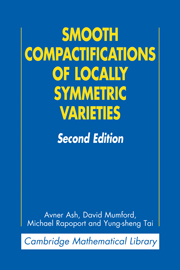III - Compactifications of locally symmetric varieties
Published online by Cambridge University Press: 23 February 2010
Summary
This chapter presents the main results of this book. In order to make the book reasonably self-contained, and because of the difficulty in assembling the known results from a very diffuse and often hard-to-read literature, we have tried to include, with at least sketches of proof, a large proportion of the needed background on hermitian symmetric spaces. We have profited greatly from lectures on hermitian symmetric spaces given by P. Deligne in Paris in 1973. Large parts of Sections 2 and 3 are no more than an elaboration of his work. One of us (Rapoport) profited also from conversations with R. P. Langlands.
Section 1 explains the method of compactification in the case of a tube domain; some of the facts established there are used later. This is also done in Satake [10].
Sections 2, 3, and 4 review facts about hermitian symmetric domains and their boundary theory. In addition to help from Deligne and Langlands, we have used principally Helgason [6] and Wolf [12], but also Harish-Chandra [5], Langlands [8], Koranyi and Wolf [7], and Satake [11].
Section 5 states the Main Theorem; Section 6 contains its proof. Here basic facts from the fundamental paper by Baily and Borel [1] are used. For the reduction theory, we have found the book by Borel [2] very useful.
- Type
- Chapter
- Information
- Smooth Compactifications of Locally Symmetric Varieties , pp. 97 - 188Publisher: Cambridge University PressPrint publication year: 2010



